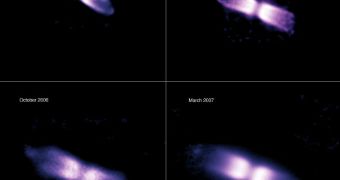Astronomers working with the European Southern Observatory's (ESO) Very Large Telescope (VLT), in Chile, have recently discovered a double star system, which appears to be housing a “vampire” star. The peculiar formation became visible to telescopes in 2000, after the star underwent an outburst that resulted in an unusual shell being ejected, after gulping up a lot of mass from its companion. Scientists believe that they may have discovered the elusive precursors of Type Ia supernovae, which are instrumental in studies related to determining the properties of dark energy, Space Fellowship reports.
“One of the major problems in modern astrophysics is the fact that we still do not know exactly what kinds of stellar system explode as a Type Ia supernova. As these supernovae play a crucial role in showing that the Universe’s expansion is currently accelerating, pushed by a mysterious dark energy, it is rather embarrassing,” explains Patrick Woudt. He is a scientist based at the University of Cape Town, in South Africa, and also the lead author of a new study reporting the findings.
The target of the research was an object known as V445, located in the constellation Puppis (“the Stern”). As of today, there are no data to suggest that Puppis V445 is a nova showing evidence for hydrogen, which is something highly unusual. The vampire star is rather a helium-dominated white dwarf – the collapsed core of an average star, unable to sustain nuclear fusion any longer – which shows evidence of outbursts. “This is critical, as we know that Type Ia supernovae lack hydrogen, and the companion star in V445 Pup fits this nicely by also lacking hydrogen, instead dumping mainly helium gas onto the white dwarf,” adds University of Warwick astronomer Danny Steeghs, also a coauthor of the new study.
The November 2000 observations showed that the system experienced a massive outburst. The white dwarf became 250 times more luminous than before, and emitted a vast amount of matter into the surrounding space. The event was captured in detail by the VLT's NACO adaptive optics instrument, which is especially fitted for this type of observations. For two years, the device collected images of the formation, generating a time-lapse video of its activities. The peculiar shell around the double system was noticed to be moving at a speed of about 24 million kilometers per hour.
“The incredible detail that we can see on such small scales – about hundred milliarcseconds, which is the apparent size of a one euro coin seen from about forty kilometers – is only possible thanks to the adaptive optics technology available on large ground-based telescopes such as ESO’s VLT,” explains Steeghs. “Whether V445 Puppis will eventually explode as a supernova, or if the current nova outburst has preempted that pathway by ejecting too much matter back into space is still unclear. But we have here a pretty good suspect for a future Type Ia supernova,” concludes Woudt.

 14 DAY TRIAL //
14 DAY TRIAL //